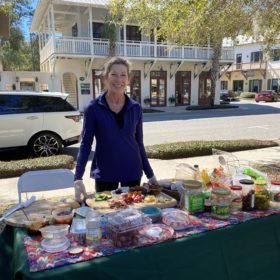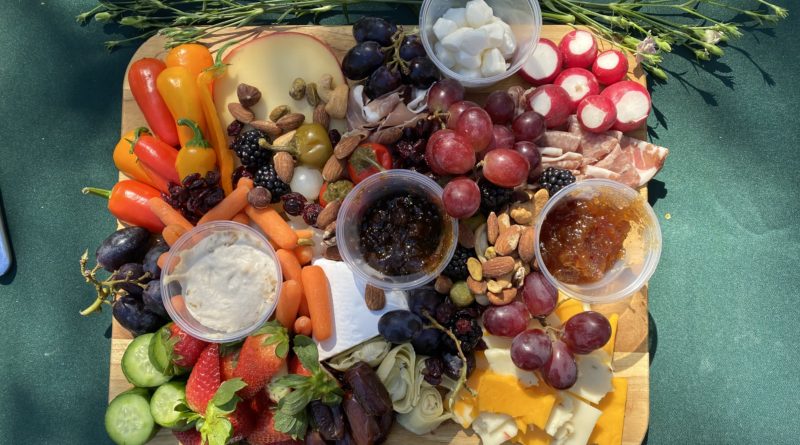The Art of Charcuterie
The Stylish Way to Snack
story by KAREN SNYDER
 One of the more pleasurable things to come out of our time spent indoors during 2020 is the ever-popular charcuterie board. As we searched for new at-home interests during pandemic times, the Art of Charcuterie found its way back into our hearts and stomachs. Around for hundreds of years, the word charcuterie is a French term that translates to “cooked flesh.” Though that might not sound so appetizing, it actually refers to 16th-century French specialty shops that offered cured and preserved meats of every kind. Today’s charcuterie craze has expanded our palates and includes everything from cured and dried meats, sausages, terrines, and pates to cheeses, nuts, fruit, jellies, and more!
One of the more pleasurable things to come out of our time spent indoors during 2020 is the ever-popular charcuterie board. As we searched for new at-home interests during pandemic times, the Art of Charcuterie found its way back into our hearts and stomachs. Around for hundreds of years, the word charcuterie is a French term that translates to “cooked flesh.” Though that might not sound so appetizing, it actually refers to 16th-century French specialty shops that offered cured and preserved meats of every kind. Today’s charcuterie craze has expanded our palates and includes everything from cured and dried meats, sausages, terrines, and pates to cheeses, nuts, fruit, jellies, and more!
Learning how to make a charcuterie board or tray can be just as creative and fun as it is delicious to eat. Recently, the Market at Celadon (MAC) located on Lady’s Island, hosted a “Lunch & Learn” workshop on the Art of Charcuterie taught by its new resident chef Judy Woodman. With more than 30 years of cooking experience, Judy joined the coffee shop and café staff last August and gladly shares her knowledge of charcuterie board-building tips.
Whether used for family snacking or serious entertaining, charcuterie has made its way to our kitchen islands, dining rooms, and our backyard picnic tables. The trick, says Woodman, is to “build a board, plate, tray, or basket that’s visually pleasing with a variety of colors and textures.” Not limited to solely meat and cheese displays, she adds that “brunch boards” as well as “dessert charcuterie” have become popular serving options too.
To start, says Woodman, choose a variety of foods that you enjoy. Whether you’re a vegan, vegetarian, or meat eater, the goal of making a charcuterie board is to customize it to suit yourself or your guests’ palates. “Buy fresh ingredients, cured meats, and cheeses from your local deli or specialty food store,” she suggests, “and pick up items such as fruits, nuts, jams and jellies, crackers, or freshly baked artisan bread from your favorite bakery.” Even bulk or warehouse grocery stores provide a great choice of jarred or pickled food items, such as olives, sweet peppers, artichoke hearts, okra, and cocktail onions.
Though choosing a special presentation board or “plank” has become a popular part of the charcuterie craze (including custom-made, build-your-own, and even personalized or engraved cutting boards), Woodman suggests finding a “simple board that has a carved out border” to be the most practical. “When you have a carved border around the sides, your round items like grapes or berries don’t roll off, and juices from them are contained,” she explains. “Keep in mind that the goal is to have the entire surface of the board covered with your food items, so you don’t see much of the board anyway.”
 The fun begins when preparing and arranging items on the board. Your mother may have told you never to play with your food, but charcuterie is undoubtedly the exception! Think creatively. Twist, roll, and twirl your thinly sliced meats, such as Prosciutto, Salami, or Soppressata into interesting patterns, petals, or even rosettes. Or stack sliced meats and cheeses in varying heights or layered rows. “I suggest that you take your meats and cheeses out of the refrigerator at least 30 minutes ahead of time as they’ll be easier to work with.”
The fun begins when preparing and arranging items on the board. Your mother may have told you never to play with your food, but charcuterie is undoubtedly the exception! Think creatively. Twist, roll, and twirl your thinly sliced meats, such as Prosciutto, Salami, or Soppressata into interesting patterns, petals, or even rosettes. Or stack sliced meats and cheeses in varying heights or layered rows. “I suggest that you take your meats and cheeses out of the refrigerator at least 30 minutes ahead of time as they’ll be easier to work with.”
“Think about color too,” adds Woodman. “Use a variety of colorful fruits and vegetables, such as yellow and orange sweet peppers, red strawberries, blackberries, green and purple grapes, or sliced cucumbers, and spread their beautiful colors throughout the display.”
In addition, Woodman suggests using small decorative bowls or tall glasses to bring dimension and even more color to the board. “A tall beverage glass can hold thin breadsticks, or a small Ramekin bowl or other serving dishes can hold jams, jellies, and pickled items, for example. Fill small bowls with tasty treats, like flavored hummus, fig or tomato jam, or peach pepper jelly to dip crackers, meats, and cheeses. “You’ll want to get some fresh-baked loaves of crusty, rustic breads to slice and serve alongside as well,” she advises.
As a finishing touch, says Woodman, consider drizzling a bit of good quality honey across your display or place some honey in a bowl with a wood dipper stick. “Topping your board off with scattered dried cranberries is a nice touch too,” she adds.
It’s clear that when creating a charcuterie board, the possibilities are endless! Just think about the number of family, friends, and guests you’ll be serving to determine the size of the board or the number of trays needed. Her final two tips: Never put anything nonedible on the board (like candles or flowers) and keep the charcuterie on the table for no more than an hour before refrigerating again.
If you need something special to serve along with your charcuterie board (or would like a board created by Chef Judy), stop by the MAC, in the Celadon Community marketplace just off Sams Point Road, and choose from its delicious menu items, daily specials, or refrigerated “grab-and-go” section.




